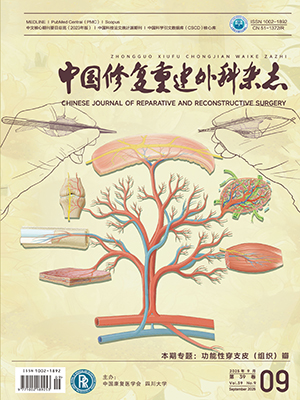Objective To investigate the safety and effectiveness of using the Taylor spatial frame (TSF) based on the Ilizarov tension-stress principle for treatment of post-burn foot and ankle deformities in adults. Methods A clinical data of 6 patients with post-burn foot and ankle deformities treated between April 2019 and November 2023 was retrospectively analyzed. There was 1 male and 5 females with an average age of 28.7 years (range, 20-49 years). There were 3 cases of simple ankle equinus, 2 cases of ankle equinus, midfoot rocker-bottom foot, and forefoot pronation, and 1 case of calcaneus foot and forefoot pronation. Preoperative American Orthopedic Foot and Ankle Society (AOFAS) score was 45.3±18.2, 12-Item Short-Form Health Survey (SF-12)-Physical Component Summary (PCS) score was 34.3±7.3 and Mental Component Summary (MCS) score was 50.4±8.8. Imaging examination showed tibial-calcaneal angle of (79.8±31.5)°, calcaneus-first metatarsal angle of (154.5±45.3)°, talus-first metatarsal angle of (–19.3±35.0)°. Except for 1 case with severe deformity that could not be measured, the remaining 5 cases had talus-second metatarsal angle of (40.6±16.4)°. The deformities were fixed with TSF after soft tissue release and osteotomy. Then, the residual deformities were gradually corrected according to software-calculated prescriptions. TSF was removed after maximum deformity correction and osteotomy healing. External fixation time, brace wearing time after removing the TSF, and pin tract infection occurrence were recorded. Infection severity was evaluated based on Checketts-Otterburns grading. Joint function was evaluated using AOFAS score and SF-12 PCS and MCS scores. Patient satisfaction was assessed using Likert score. Imaging follow-up measured relevant indicators to evaluate the degree of deformity correction. Deformity recurrence was observed during follow-up. Results The external fixation time was 103-268 days (mean, 193.5 days). The mild pin tract infections occurred during external fixation in all patients, which healed after pin tract care and oral antibiotics. No serious complication such as osteomyelitis, fractures, neurovascular injury, or skin necrosis occurred. After external fixation removal, 3 cases did not wear braces, while the remaining 3 cases wore braces continuously for 6 weeks, 8 weeks, and 3 years, respectively. All patients were followed up 13.9-70.0 months, with an average of 41.7 months. During follow-up, none of the 6 patients had recurrence of foot deformity. At 1 year after operation, the AOFAS score was 70.0±18.1, SF-12-PCS and MCS scores were 48.9±4.5 and 58.8±6.4, respectively, all showing significant improvement compared to preoperative values (P<0.05). Imaging follow-up showed that all osteotomies healed, and all distraction cases achieved bony union at 6 months after stopping stretching. At 1 year after operation, tibial-calcaneal angle was (117.5±12.8)° and talus-first metatarsal angle was (–3.3±19.3)°, both showing significant improvement compared to preoperative values (P<0.05). Calcaneus-first metatarsal angle was (132.0±14.4)°, which also improved compared to preoperative values but without significant difference (P>0.05). Except for 1 case with severe deformity that could not be measured, the remaining 5 cases had talus-second metatarsal angle of (18.0±6.4)°. And there was no significant difference (P>0.05) between pre-and post-operative data of 4 patients with complete data. At 1 year after operation, 1 patient was satisfied with effectiveness and 5 patients were very satisfied. Conclusion The TSF, by applying the Ilizarov tension-stress principle for gradual distraction and multi-planar adjustment, combined with soft tissue release and osteotomy, can effectively correct foot and ankle deformities after burns, especially equinus deformity with contracture of the posterior soft tissues of the lower leg. There are still limitations in treating cases with tight, adherent scars on the dorsum of the foot that require long-distance distraction. If necessary, a multidisciplinary approach combined with microsurgical techniques can be utilized.
Citation:
GU Jianming, WANG Shihao, DU Hui, ZHOU Yixin. Application of Taylor spatial frame for treating post-burn foot and ankle deformities in adults. Chinese Journal of Reparative and Reconstructive Surgery, 2025, 39(8): 974-981. doi: 10.7507/1002-1892.202504123
Copy
Copyright © the editorial department of Chinese Journal of Reparative and Reconstructive Surgery of West China Medical Publisher. All rights reserved




